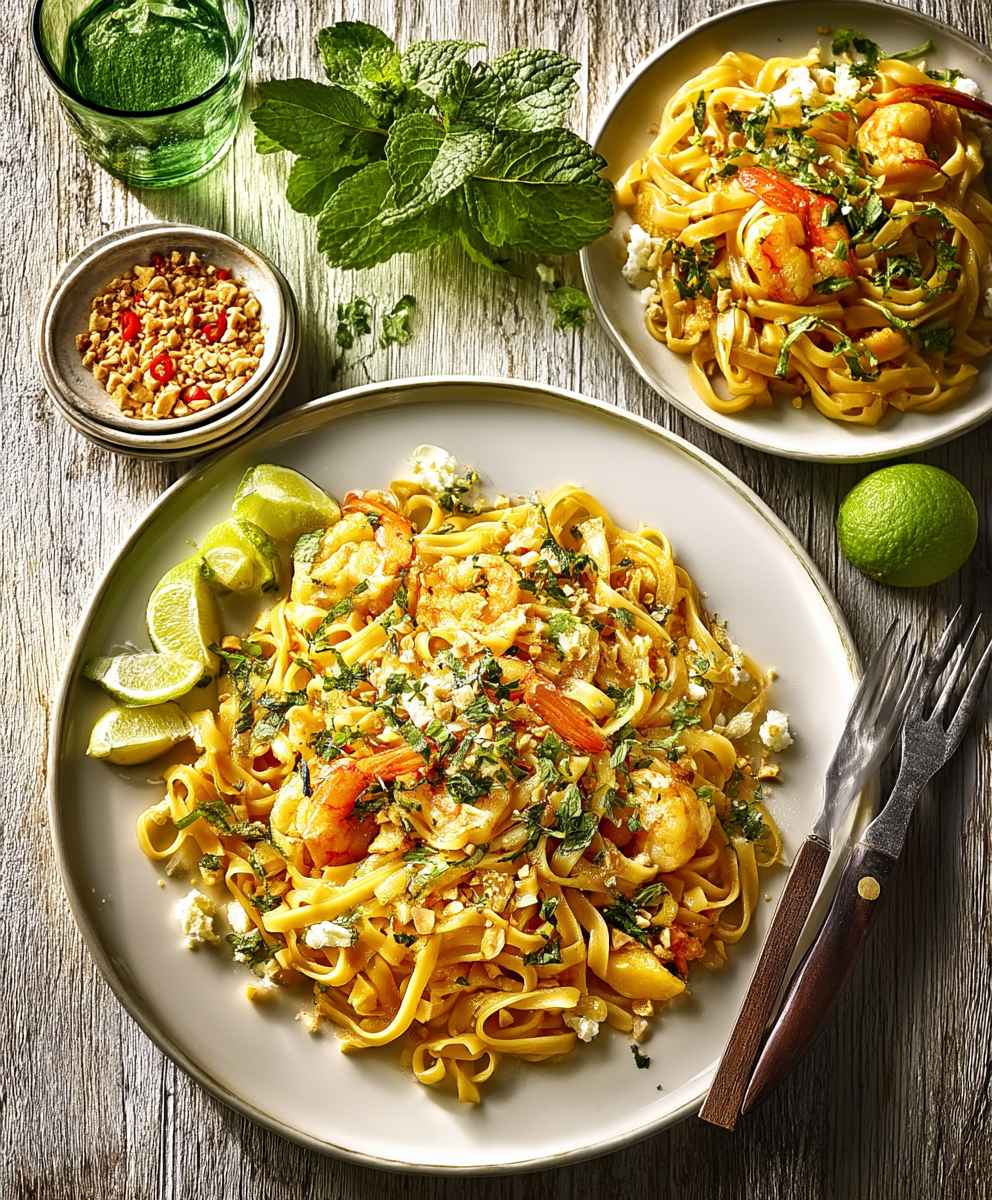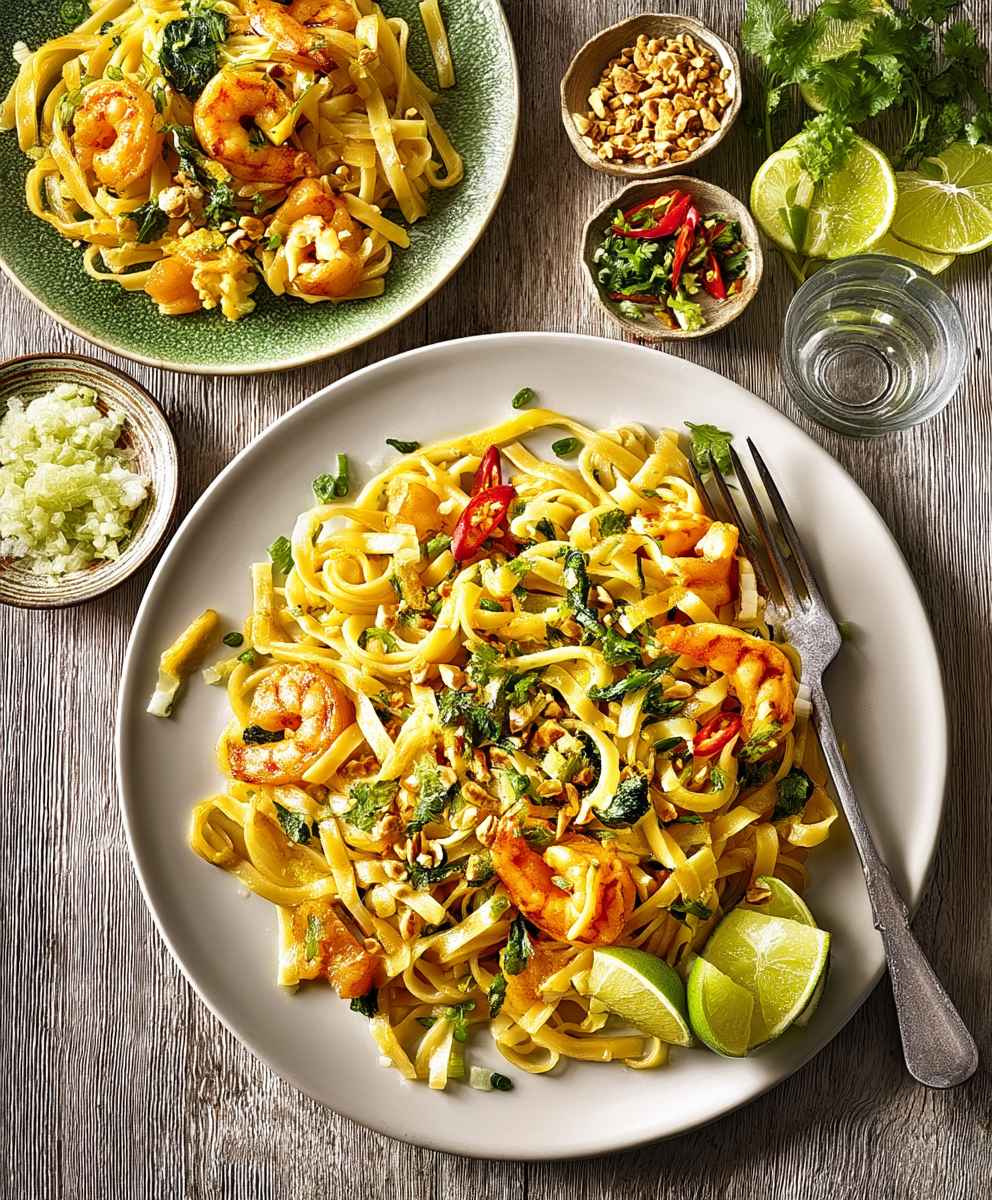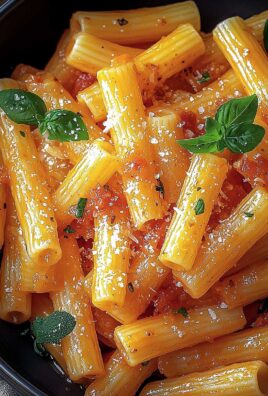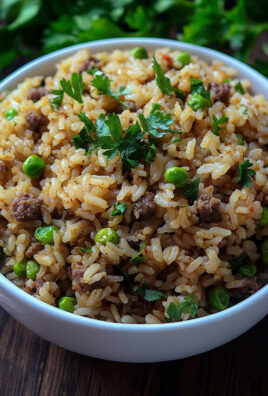Authentic Pad Thai, a symphony of sweet, sour, and savory flavors dancing on your palate, is more than just a noodle dish; it’s a culinary journey to the heart of Thailand. Have you ever craved that perfect Pad Thai, the kind that transports you to a bustling Bangkok street food stall with every bite? I know I have! And after countless attempts, I’m thrilled to share a recipe that truly captures the essence of this iconic dish.
While often considered Thailand’s national dish, Pad Thai’s history is surprisingly recent. It emerged in the 1930s as part of a national identity campaign, designed to promote unity and reduce rice consumption. The government encouraged its citizens to embrace this new noodle dish, and it quickly gained popularity, becoming a symbol of Thai cuisine.
What makes Authentic Pad Thai so irresistible? It’s the harmonious blend of textures the chewy rice noodles, the crunchy peanuts, the crisp bean sprouts combined with the explosion of flavors. The tangy tamarind paste, the salty fish sauce, the sweet palm sugar, and the spicy chili flakes create a truly unforgettable experience. Plus, it’s relatively quick and easy to make at home, making it a perfect weeknight meal that’s sure to impress. So, let’s embark on this culinary adventure together and create a Pad Thai that will rival your favorite Thai restaurant!
Ingredients:
- For the Noodles:
- 8 ounces dried flat rice noodles (about ¼ inch wide)
- For the Pad Thai Sauce:
- ¼ cup tamarind paste
- ¼ cup fish sauce
- ¼ cup palm sugar (or brown sugar)
- 2 tablespoons rice vinegar
- 1 tablespoon soy sauce
- 1 teaspoon chili garlic sauce (or sriracha, adjust to taste)
- For the Stir-Fry:
- 2 tablespoons vegetable oil
- 2 cloves garlic, minced
- 1 shallot, thinly sliced
- 4 ounces firm tofu, pressed and cubed
- 4 ounces shrimp, peeled and deveined (or chicken, pork, or beef, thinly sliced)
- 2 large eggs, lightly beaten
- ½ cup bean sprouts
- ¼ cup garlic chives, cut into 1-inch pieces (or green onions)
- ¼ cup roasted peanuts, chopped
- For Garnish:
- Lime wedges
- Extra roasted peanuts, chopped
- Extra bean sprouts
- Chili flakes (optional)
- Cilantro (optional)
Preparing the Noodles:
- Soak the Noodles: This is a crucial step! Place the dried rice noodles in a large bowl and cover them with hot (but not boiling) water. The water should be hot enough to soften the noodles but not cook them. Stir them gently to ensure they are all submerged. Soak for about 20-30 minutes, or until the noodles are pliable but still firm to the touch. They should bend easily without breaking. The soaking time will vary depending on the thickness of your noodles, so check them frequently.
- Drain the Noodles: Once the noodles are properly soaked, drain them thoroughly in a colander. Rinse them with cold water to stop the cooking process and prevent them from sticking together. Set them aside. If you’re not using them immediately, toss them with a little vegetable oil to keep them from clumping.
Making the Pad Thai Sauce:
- Combine the Ingredients: In a small saucepan, combine the tamarind paste, fish sauce, palm sugar (or brown sugar), rice vinegar, soy sauce, and chili garlic sauce (or sriracha).
- Simmer the Sauce: Place the saucepan over medium heat and bring the mixture to a simmer. Stir constantly until the palm sugar is completely dissolved and the sauce has thickened slightly. This usually takes about 5-7 minutes. Taste the sauce and adjust the seasonings as needed. If it’s too sour, add a little more sugar. If it’s not salty enough, add a little more fish sauce. If you want it spicier, add more chili garlic sauce.
- Cool the Sauce: Remove the saucepan from the heat and let the sauce cool slightly. The sauce will thicken further as it cools. You can store the sauce in an airtight container in the refrigerator for up to a week.
Stir-Frying the Pad Thai:
- Prepare the Wok (or Large Skillet): Heat a wok or large skillet over high heat. Make sure the wok is very hot before adding the oil. This will help prevent the noodles from sticking.
- Add Aromatics: Add the vegetable oil to the hot wok. Once the oil is hot, add the minced garlic and sliced shallots. Stir-fry for about 30 seconds, or until fragrant. Be careful not to burn the garlic.
- Cook the Tofu and Shrimp (or Protein of Choice): Add the cubed tofu to the wok and stir-fry for about 2-3 minutes, or until lightly golden brown. Then, add the shrimp (or your chosen protein) and stir-fry until cooked through. If using chicken, pork, or beef, make sure it is thinly sliced and cooked until no longer pink. Remove the tofu and shrimp from the wok and set aside.
- Scramble the Eggs: Add the lightly beaten eggs to the wok and cook, stirring constantly, until they are scrambled. Break the eggs into smaller pieces with your spatula.
- Add the Noodles: Add the soaked and drained rice noodles to the wok. Stir-fry for about 1 minute to heat them through.
- Add the Pad Thai Sauce: Pour the Pad Thai sauce over the noodles and stir-fry to coat the noodles evenly. Make sure the sauce is well distributed.
- Combine Ingredients: Add the cooked tofu and shrimp (or protein) back to the wok. Stir-fry to combine all the ingredients.
- Add Bean Sprouts and Garlic Chives: Add the bean sprouts and garlic chives (or green onions) to the wok. Stir-fry for about 30 seconds, or until the bean sprouts are slightly wilted but still crunchy.
- Incorporate Peanuts: Stir in the chopped roasted peanuts.
- Serve Immediately: Remove the Pad Thai from the wok and serve immediately.
Plating and Garnishing:
- Portion and Plate: Divide the Pad Thai among individual serving plates.
- Garnish Generously: Garnish each plate with lime wedges, extra chopped roasted peanuts, extra bean sprouts, chili flakes (if desired), and cilantro (if desired).
- Serve Hot: Serve the Pad Thai hot and enjoy! The lime wedges are essential for adding a burst of freshness and acidity to the dish. Squeeze the lime juice over the Pad Thai just before eating.
Tips for the Best Pad Thai:
- Noodle Selection: Using the correct type of rice noodle is crucial. Look for dried flat rice noodles that are about ¼ inch wide. Thicker noodles will take longer to cook and may become gummy.
- Tamarind Paste: Tamarind paste is a key ingredient in Pad Thai sauce, giving it its signature sour and tangy flavor. You can find tamarind paste at most Asian grocery stores. If you can’t find tamarind paste, you can substitute it with a mixture of lime juice and brown sugar, but the flavor won’t be quite the same.
- Palm Sugar: Palm sugar adds a unique sweetness to Pad Thai sauce. If you can’t find palm sugar, you can substitute it with brown sugar.
- Don’t Overcook the Noodles: Overcooked noodles will become mushy and unappetizing. Be careful not to oversoak or overcook the noodles. They should be pliable but still firm to the touch.
- High Heat is Key: Stir-frying over high heat is essential for achieving the characteristic wok hei (wok breath) flavor. Make sure your wok or skillet is very hot before adding the oil.
- Work Quickly: Once you start stir-frying, work quickly to prevent the noodles from sticking and the ingredients from overcooking.
- Adjust Seasonings to Taste: Taste the Pad Thai sauce and adjust the seasonings as needed. Pad Thai should be a balance of sweet, sour, salty, and spicy flavors.
- Fresh Ingredients: Using fresh ingredients will make a big difference in the flavor of your Pad Thai. Use fresh garlic, shallots, bean sprouts, and garlic chives (or green onions).
- Garnish with Love: Don’t skimp on the garnishes! Lime wedges, chopped roasted peanuts, bean sprouts, chili flakes, and cilantro add flavor, texture, and visual appeal to the dish.
- Practice Makes Perfect: Pad Thai can be a bit tricky to make at first, but with practice, you’ll get the hang of it. Don’t be afraid to experiment and adjust the recipe to your liking.
Variations:
- Vegetarian Pad Thai: To make vegetarian Pad Thai, omit the shrimp and fish sauce. Substitute the fish sauce with soy sauce or vegetarian fish sauce. You can also add extra tofu or other vegetables, such as broccoli, carrots, or bell peppers.
- Chicken Pad Thai: Substitute the shrimp with thinly sliced chicken breast.
- Pork Pad Thai: Substitute the shrimp with thinly sliced pork loin.
- Beef Pad Thai: Substitute the shrimp with thinly sliced beef sirloin.
- Spicy Pad Thai: Add more chili garlic sauce or sriracha to the Pad Thai sauce to make it spicier. You can also add

Conclusion:
This isn’t just another recipe; it’s your passport to experiencing truly authentic Pad Thai right in your own kitchen. From the perfectly balanced sweet, sour, and savory notes to the satisfying chew of the noodles and the delightful crunch of the peanuts, every element works in harmony to create a dish that’s both comforting and exciting. I know there are a million Pad Thai recipes out there, but trust me, this one is different. It’s the real deal, the kind you’d find in a bustling Bangkok street market, and I’ve poured my heart into making it accessible for you.
Why is this a must-try? Because it’s more than just a meal; it’s an experience. It’s about connecting with a culture through its cuisine, about understanding the nuances of flavor, and about creating something truly special for yourself and your loved ones. It’s about ditching the takeout and embracing the joy of homemade goodness. Plus, let’s be honest, who doesn’t love Pad Thai?
But the best part? It’s incredibly versatile! Feel free to experiment with different protein options. Shrimp is classic, of course, but chicken, tofu, or even thinly sliced beef work beautifully. For a vegetarian twist, load it up with extra vegetables like bean sprouts, carrots, and bell peppers. And if you’re feeling adventurous, try adding a touch of chili oil for an extra kick.
Serving Suggestions and Variations:
* Garnish is Key: Don’t skimp on the garnishes! A generous sprinkle of chopped peanuts, fresh cilantro, and a wedge of lime are essential for that authentic Pad Thai experience.
* Spice it Up: If you like a little heat, add a pinch of red pepper flakes or a drizzle of sriracha to your serving.
* Make it a Meal: Serve your Pad Thai with a side of spring rolls or a refreshing cucumber salad for a complete and satisfying meal.
* Tofu Power: For a vegan option, use firm or extra-firm tofu, pressed to remove excess water, and pan-fried until golden brown.
* Seafood Sensations: Add a mix of shrimp, scallops, and calamari for a truly decadent Pad Thai experience.I truly believe that anyone can make this authentic Pad Thai recipe, regardless of their cooking experience. The key is to follow the instructions carefully and to use fresh, high-quality ingredients. Don’t be intimidated by the list of ingredients; most of them are readily available at your local Asian grocery store or even in the international aisle of your regular supermarket. And remember, cooking should be fun! So put on some music, pour yourself a glass of wine, and enjoy the process.
I’m so excited for you to try this recipe and experience the magic of authentic Pad Thai for yourself. Once you do, I’d absolutely love to hear about your experience! Did you make any modifications? What did your family and friends think? Share your photos and stories in the comments below. Let’s create a community of Pad Thai enthusiasts! I can’t wait to see what you create. Happy cooking!
Authentic Pad Thai: The Only Recipe You'll Ever Need
Classic Pad Thai with rice noodles, tofu, shrimp, and a tangy tamarind sauce, garnished with peanuts, bean sprouts, and lime.
Ingredients
- 8 ounces dried flat rice noodles (about ¼ inch wide)
- ¼ cup tamarind paste
- ¼ cup fish sauce
- ¼ cup palm sugar (or brown sugar)
- 2 tablespoons rice vinegar
- 1 tablespoon soy sauce
- 1 teaspoon chili garlic sauce (or sriracha, adjust to taste)
- 2 tablespoons vegetable oil
- 2 cloves garlic, minced
- 1 shallot, thinly sliced
- 4 ounces firm tofu, pressed and cubed
- 4 ounces shrimp, peeled and deveined (or chicken, pork, or beef, thinly sliced)
- 2 large eggs, lightly beaten
- ½ cup bean sprouts
- ¼ cup garlic chives, cut into 1-inch pieces (or green onions)
- ¼ cup roasted peanuts, chopped
- Lime wedges
- Extra roasted peanuts, chopped
- Extra bean sprouts
- Chili flakes (optional)
- Cilantro (optional)
Instructions
- Soak the Noodles: Place the dried rice noodles in a large bowl and cover with hot (not boiling) water. Soak for 20-30 minutes, until pliable but firm.
- Drain the Noodles: Drain thoroughly in a colander. Rinse with cold water to stop cooking. Toss with a little oil if not using immediately.
- Make the Pad Thai Sauce: Combine tamarind paste, fish sauce, palm sugar (or brown sugar), rice vinegar, soy sauce, and chili garlic sauce in a saucepan.
- Simmer the Sauce: Simmer over medium heat, stirring constantly, until sugar dissolves and sauce thickens slightly (5-7 minutes). Adjust seasonings to taste. Cool slightly.
- Prepare the Wok: Heat a wok or large skillet over high heat.
- Add Aromatics: Add vegetable oil, then minced garlic and sliced shallots. Stir-fry until fragrant (about 30 seconds).
- Cook Tofu and Shrimp: Add cubed tofu and stir-fry until lightly golden (2-3 minutes). Add shrimp (or protein) and stir-fry until cooked through. Remove from wok and set aside.
- Scramble the Eggs: Add beaten eggs to the wok and cook, stirring constantly, until scrambled. Break into smaller pieces.
- Add the Noodles: Add soaked and drained noodles to the wok. Stir-fry for about 1 minute to heat through.
- Add the Pad Thai Sauce: Pour Pad Thai sauce over noodles and stir-fry to coat evenly.
- Combine Ingredients: Add cooked tofu and shrimp (or protein) back to the wok. Stir-fry to combine.
- Add Bean Sprouts and Garlic Chives: Add bean sprouts and garlic chives (or green onions). Stir-fry for about 30 seconds, until bean sprouts are slightly wilted.
- Incorporate Peanuts: Stir in chopped roasted peanuts.
- Serve Immediately: Remove from wok and serve immediately.
- Garnish: Garnish with lime wedges, extra peanuts, bean sprouts, chili flakes (optional), and cilantro (optional). Serve hot.
Notes
- Use ¼ inch wide flat rice noodles.
- Tamarind paste is key for the signature sour flavor.
- Palm sugar adds unique sweetness; brown sugar can substitute.
- Don’t overcook the noodles.
- High heat is essential for wok hei flavor.
- Work quickly while stir-frying.
- Adjust seasonings to taste (sweet, sour, salty, spicy).
- Use fresh ingredients for best flavor.
- Don’t skimp on garnishes.
- Practice makes perfect!





Leave a Comment